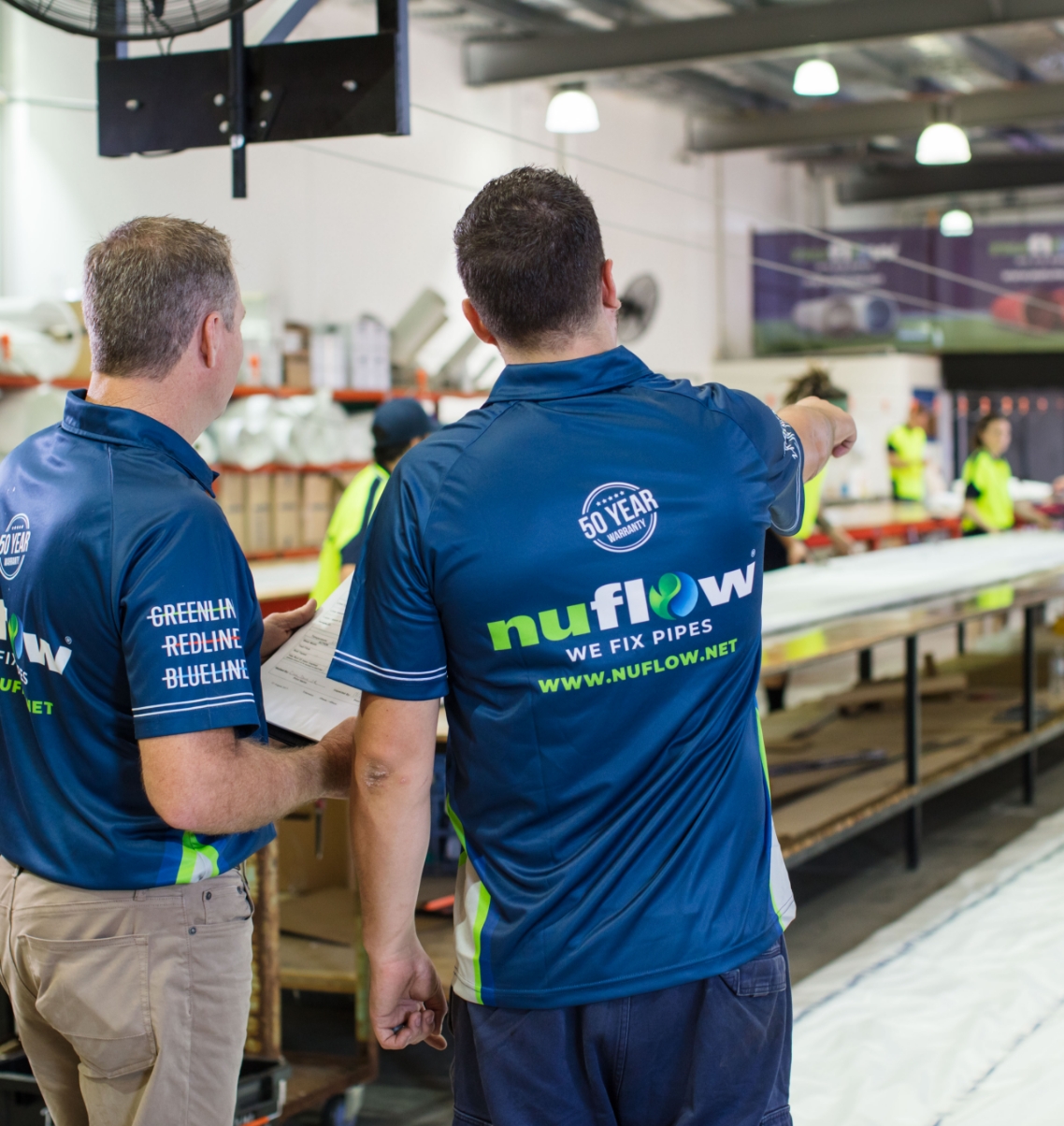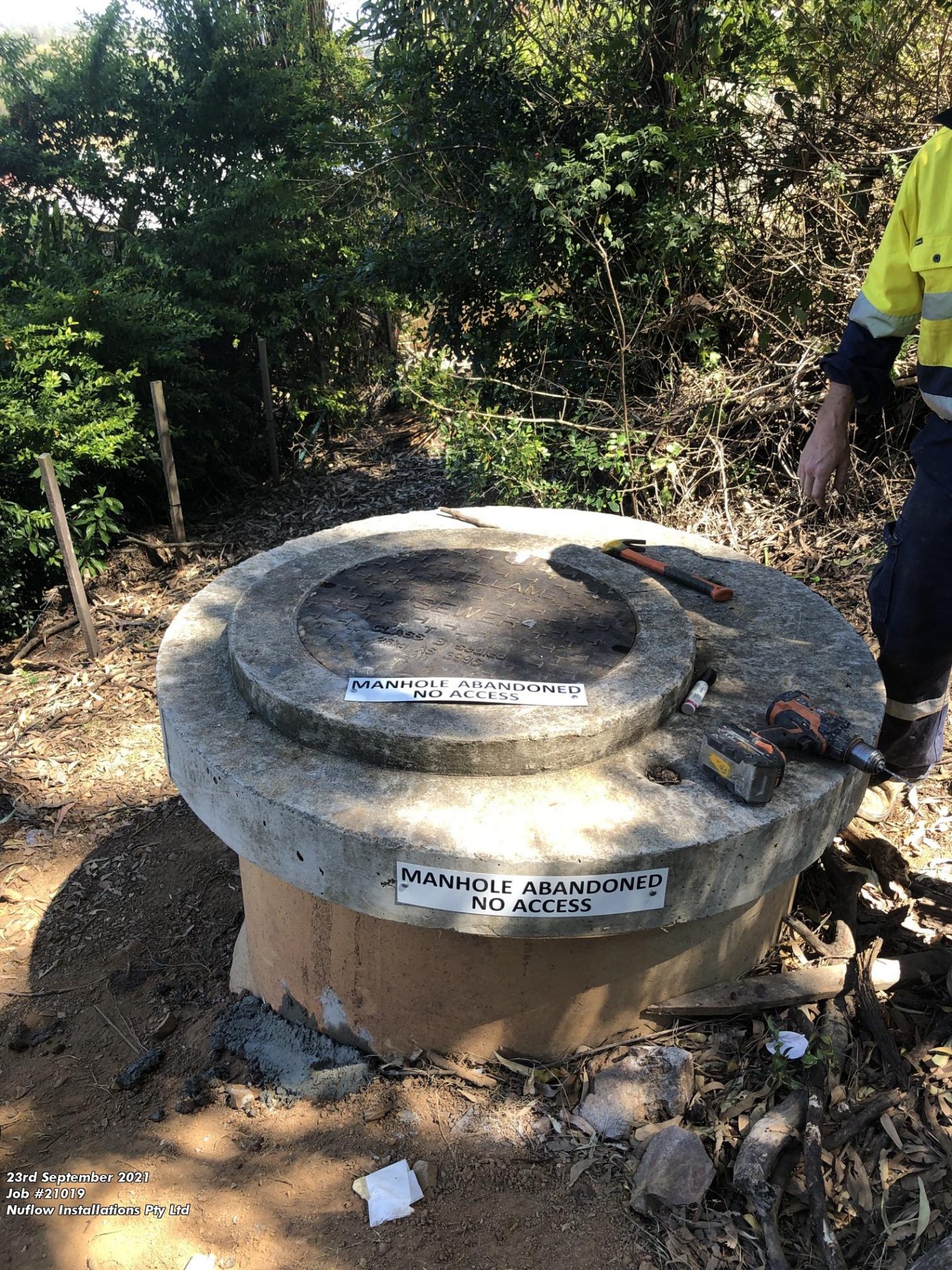A storm water stack hidden behind a brick wall at a Queensland beachside resort was causing havoc until the Nuflow team brought the sunshine back into everyone’s day with its Blueline solution.
THE CLIENT
Crown Towers Resort, Surfers Paradise, Queensland.
THE PROBLEM
Building movement had caused numerous small cracks in 105 metres of 225mm FRC/AC storm water pipe at a 42-storey high-rise resort. The pipe was enclosed behind a brick and concrete wall making access difficult and repair or replacement impractical. The line included some junctions, elbows and bends.
THE SOLUTION
Relining with Blueline on the two straight sections of pipe (1 x 70m and 1 x 35m) and relining of one junction found to have cracks.
TIME TAKEN TO RESOLVE THE ISSUE
Two weeks – although there was no impact on operations and no urgency to complete works quickly.
DISRUPTION TO SERVICES, LIFESTYLE, FUNCTIONALITY
None.
COST SAVING OVER REMOVAL AND REPLACEMENT OF PIPES
Excavation and demolition costs (for removal and replacement) and disruption to operations would have been significantly higher.
OTHER BENEFITS
- A small environmental footprint
- No more ongoing repair and refurbishment costs for damaged units
- A 50-year warranty gave management and body corporate committee peace of mind
- No disruption to residents and guests at all
INACCESSIBLE STORM WATER PIPES CALL FOR CREATIVE SOLUTIONS
Whoever said tradesmen weren’t exactly creative types better think again. Whether it’s uncovering the cause of a blocked pipe, figuring out how the stormwater pipes track in a 50-year-old high-rise or coming up with the best way to fix a ‘hard-to-get-to’ leaking drain, good plumbers not only need know-how and experience, they need curious and creative minds just itching to get to work.
And those creative juices were working overtime when Nuflow Gold Coast was tasked with relining the vertical stormwater network at the Crown Towers Resort in Surfers Paradise. The family-friendly resort less than 100m from the coast’s iconic golden beaches has 1, 2, and 3-bedroom apartments for permanent residents and holiday makers, as well as a penthouse, restaurants, day spa and tropical lagoon pool. Its proximity to virtually all things ‘holiday’ made it the perfect place to relax and play – rain, hail or shine – until cracks in the stormwater stack meant a bit too much of that rain was ending up where it didn’t belong.
STORMWATER PIPE PROBLEMS
Built in 1997, the well-maintained, 42-storey, luxury resort has rooms with amazing views over the ocean, but a construction decision to locate the entire 105 metres of vertical stormwater pipe in a recess behind a besser brick and concrete wall meant a major headache a few decades later for building Maintenance Manager, Neale Sutherland.
“The pipe was pretty much inaccessible behind that wall,” he said.
“It was a fibre reinforced (FRC) concrete pipe and over time the building’s movement had caused some cracks, especially around where it was clamped onto the wall.
“When water started seeping through the cracks, it wasn’t long before a few of the units started getting damage during heavy rain.”
Sutherland said early signs began about seven years ago.
“It wasn’t a big issue at first.
“Our plumber would just go into the affected apartment and cut a hole through the wall and into the pipe then spot-fix the leak and that’d be it for a while, but then every few years another one would come along a bit lower or a bit higher.”
Crown Towers Resort Lobby
The building has two profiles; the lower 11 floors have a wider perimeter with 15 units on each accommodation level, while the slimmer ‘Tower’ section (from levels 12-39) sits on top and has only six units on each floor.
Roof water is channelled into a 150mm PVC pipe and then into the 225mm AC pipe that was thought to run in a straight line down to the ground. Most of the leaks were occurring on the lower floors (from 12 down) and as the frequency and severity of the damage increased, it became clear the spot-fixing wasn’t going to be enough.
“Something had to be done because it just kept happening, but with the pipes hidden behind that wall, we didn’t really know what,” Sutherland said.
“When it started getting worse we cut through the gyprock and besser blocks in the fire hose reel room on level 12 to get to expose pipes.
“We set up a foam sleeve and bucket to catch the water, but it got to the point where we were emptying out the bucket every half hour in heavy rain and that told us we had bigger cracks than we’d thought.
“That’s when it came to the crunch.”
WHY PIPE RELINING WAS THE BEST OPTION
Rather than one large area of damage, the many small cracks that had appeared over time meant during heavy rain, water would seep through to the outside face of the pipe in a number of areas and trickle down. Every four or so levels there was a concrete support slab butting up against the pipe, and the trickling water would hit that then fan out across the slab, meaning water would enter those apartments above and/or below the slab.
Unbeknownst to everyone at this early stage, the storm water stack was in fact not one long pipe, but two, joined by a series of twisting elbows and bends. The first length from the roof ended at the bottom of the Tower, on level 12, which meant most of that trickling water left the pipe here and travelled across the slab into a myriad of cracks and crevices that carried it to units on levels below.
Although it’s a mixed-use building (holiday and permanent accommodation) all units are privately owned so deciding on the best pipe repair strategy was a matter for the body corporate committee. Sutherland and his team set to work researching options to present to them.
Replacing the existing pipe was really not viable. Every unit running down that side of the building would need walls removed in order to gain access to the old pipe and small sections of replacement pipe would have to be installed at a time. This would not only have caused significant disruption to residents and guests, but the cost would have been exorbitant.
They then considered whether running a new pipe on the external façade of the building would work, however this would have detracted from the building’s aesthetics and could have created additional unknown costs that would have been difficult to plan for.
They even looked at whether running a new pipe inside the existing one would work.
“At one stage we thought about getting a quote along the lines of putting a smaller pipe inside the larger one,” Sutherland said.
“But the feasibility of the idea wasn’t great.
“Like, where would the pipes start and finish, and how would they join it?
“It just would have all been a bit too hard because of the pipes being in that alcove – a concealed recess behind the concrete wall – so you couldn’t have got to them.”
There were also questions about whether a smaller pipe would be adequate to cope with the high volume of water in very heavy rain.
But the one suggestion that kept coming up was relining.
WHY NUFLOW?
General Manager at Crown Towers, Justin Cave, oversaw the complex project and along with Sutherland, was working through possible repair alternatives.
“It was certainly an interesting challenge,” Cave admitted.
“We were all wondering why the pipes had been installed that way without any access.
“If we hadn’t been able to reline the pipe, we would have had to knock all sorts of holes in all sorts of walls to physically find out where the leaks were coming from.
“We got numerous recommendations along the way as part of our investigations and we spoke to a few different plumbers.
“On a couple of occasions Nuflow was recommended as the solution to our particular problem.”
They contacted Nuflow Gold Coast, who sent a team quickly to the site. Sutherland explained what had been happening and the remedies they’d tried, but with the pipe being hidden behind the brick wall, it was difficult to assess the full extent of the damage.
Despite this, the Nuflow team was fully confident they could get the job done.
“They submitted some quotes and then they came to a few body corporate meetings to discuss the process, how they would do it and what would happen,” Sutherland said.
“It seemed like it was just the most cost-effective way to do it and apart from everything else the guarantee or the warranty that came with it made up a lot of people’s minds.
“To have the job done with the peace of mind knowing it’s got a 50-year warranty that really helps, and so everyone okayed it.”
THE RELINING PROCESS AT CROWN
Nuflow Gold Coast relining technician, Jade Slater, said this was one of the many “interesting” jobs he’s done in his two and half years with the company.
“It’s funny how often what you think they should have done with the pipes, just isn’t what you find,” he said.
“Like maybe they’d originally planned to go straight down with this storm water pipe but then an electrician or whoever put something in the way and so they had to put bends and joins in their plumbing to go around it.
“When they’re in the construction stage everyone just wants to get the job done as best they can but often they don’t think about the maintenance down the track, so we get this sort of thing a lot.
“With this one we were told the storm water went straight down in just one long length of pipe from the roof to the basement which seemed logical, but once we got our CCTV cameras down inside we found that wasn’t the case.
“The pipe actually goes from the roof down to level 11 at about a 70 degree gradient, then offsets on a 90 bend, goes a couple of metres horizontally, then another bend, then down about a metre, then another bend and again back to horizontal so it steps out like a good three metres and then goes straight again down to the basement.”
The footage also showed the numerous small cracks along the straight lengths of AC pipe and the failed patches that had been previously applied. The bends, fortunately, did not show any signs of cracking, so it was decided the problem could be fixed by relining both of the straight sections only.
Slater and the rest of the Nuflow team assessed the pipe and building access and decided they could get the job done with least disruption to residents by working from the rooftop (for their initial access point) and from the common area on level 11 (for their second access point). For the bottom 35m section of pipe a downstream access point was established in the reception lobby and the winch relocated to level 11.
After smashing through the brick walls and then through the concrete pipe on the roof (as no access points had been installed in the pipe) they drilled bolts into the wall and set up a winch system to help raise the heavy liners and bladders into and out of the pipe.
Finding somewhere with enough space to spread the liners out and prepare them for insertion was the next issue. They initially planned to reline the pipe in 10m sections, but after the first reline this was modified to 6m because the location of the winch on the wall meant it struggled to lift the 10m bladder back up to the rooftop.
Finally, they had to be sure the pipe stayed dry while the relining was done. Each morning they’d assess the weather, and so long as heavy rain looked unlikely, they’d insert a 150mm bung into the feeder pipe on the roof and continue with the job. This prevented any rain entering the storm water stack, and meant only one lost day due to rain.
Because the relining process they’d set up would have no impact on residents, completion time was not an issue. The team of 3-4 installers began around 6am each day and finished around 5pm, relining two 6m lengths (12m)/day for the first drop. With the second drop (from level 11 to the basement) they could only manage two 3m liners (6m)/day because of the network of junctions and bends they had to negotiate.
“If they’d needed the job done urgently we would have just kept working through the night as well,” Slater said.
“But that would have meant penalty rates.
“Seeing as the whole thing was done in less than two weeks with the residents hardly even knowing we were there, that would have been an unnecessary expense.”
But there was still one last hurdle to overcome. Just after the bends on level 11 their initial camera footage had shown a 100mm line dropping into the 225mm pipe, which was later identified as the line picking up the air-conditioning units in the apartments. This junction (where it met the AC pipe) was particularly inaccessible, and given that there were no obvious cracks around the area, they decided against trying to install a junction liner. They lined right up to its edges and hoped that would be enough, but it wasn’t to be.
“When they told us there was a leak around the junction it was obviously disappointing, but it had to be fixed,” Slater said.
“We knew we’d have to get a liner in there somehow, but the difficulty was working out how on earth we were going to get enough access to the pipe to be able to pull it into place.
“We investigated multiple lines and couldn’t find the one we were after, so we had to come up with another way of getting access.
“The stack dropped down the inside a wall in the vacant unit we were working in front of so we cut into the cavity and one of us climbed into the tiny space to cut a hole on top of the 100mm pipe.
“That gave us our first access point and then we cut another one in the main pipe to give us downstream access.
“It was pretty tricky given we had no room to move but we did it and it’s been flood-tested and thankfully there were no more leaks.”
ANOTHER SUCCESSFUL PIPE RELINE JOB
Understandably, there were a lot of happy people once the final, successful water test was completed. Apartment owners were happy they didn’t have to worry about further flooding, the body corporate committee were happy they no longer had to spend thousands of dollars replacing walls and carpets, Cave was happy the job had been done successfully, on time, and with no disruption to residents and guests, and Sutherland was happy he didn’t have to run around with buckets or face the ire of unhappy tenants every time it rained.
In fact Sutherland was so impressed with the product and service he assured Slater he’d be calling Nuflow for any blockages or pipe maintenance issues they had in the future.
“They were good,” he said.
“Ten out of ten!
“We found a few little problems after they’d finished and they came straight back and rectified it so they were sweet.”
And Cave agrees.
“I think what was really striking was that because of the complexity of the design, the team were really focused on working with us to overcome the hurdles that they came across,” he said.
“It wasn’t until they actually got in and started that they knew what they were in for and there were complications along the way.
“But they were really good at working with us to find solutions and overcoming those complications – so that for me was really positive.
“Nothing was too hard.
“They just worked through it and yeah, got the job done.
“From the moment we engaged them right through the whole project they were just really good to work with.”




